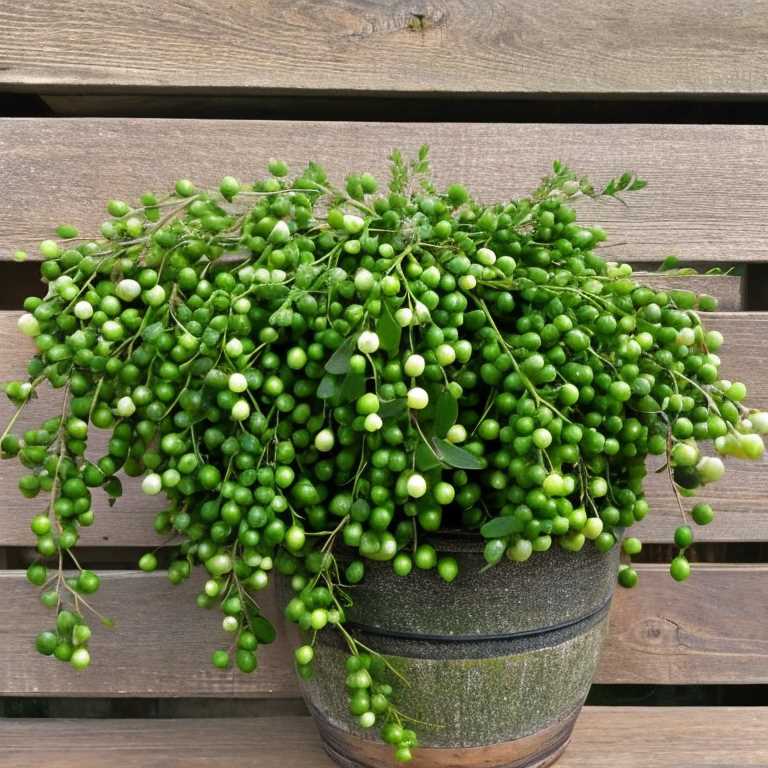How much light does string of pearls need

String of pearls, otherwise called Senecio rowleyanus, is a unique and fascinating trailing succulent plant that is native to South Africa. Its distinctive feature is its small, round, pea-like leaves that resemble a string of pearls. This plant is becoming increasingly popular and is loved by many due to its decorative and charming appearance. If you are one of the plant enthusiasts who would like to grow a string of pearls, you might be wondering how much light it needs to thrive. In this article, we will discuss the lighting requirements of string of pearls in detail.
Light Requirements of String of Pearls
Like most succulent plants, the string of pearls requires ample sunlight to grow and maintain its physical appearance. However, it is important to note that too much direct sunlight can damage the plant. Ideally, the plant should be placed in a location where it can receive bright, indirect sunlight for at least six to eight hours a day. This means that the plant should be kept near a window or in a location where it can receive filtered light.
If you live in an area that receives a lot of sunshine, it is advisable to provide shade for the plant during the hottest part of the day. This can be achieved by placing a sheer curtain or a shade cloth over the window to reduce the intensity of the sunlight. Alternatively, you can place the plant in a location that receives morning sunlight and afternoon shade.
If you do not have access to natural light, you can use artificial light to provide the necessary illumination for your string of pearls. LED grow lights are a great option as they provide the right spectrum of light that plants need to grow. These lights can be placed above the plant for at least 12 hours a day to simulate natural sunlight.
How to Tell if Your String of Pearls is Receiving Adequate Light
To determine if your string of pearls is receiving the right amount of light, you need to observe its physical appearance. A healthy string of pearls plant should have green, plump leaves that are tightly spaced along the stem. The leaves should be firm to the touch and should not be wilted or brown. If the plant is receiving inadequate light, the leaves may start to stretch out, become elongated, and have larger spaces between them. This is an indication that the plant is reaching out for more light.
On the other hand, if the plant is receiving too much light, the leaves may start to turn yellow, brown or even black. This is an indication that the plant is getting burned by the direct sunlight. If this happens, it is advisable to move the plant to a location where it can receive filtered light.
Tips for Growing a Healthy String of Pearls
Apart from providing the right amount of light, there are other factors that you need to consider to ensure that your string of pearls plant grows healthy and strong. These include:
1. Soil: The string of pearls prefers well-draining soil that is rich in organic matter. You can use a cactus or succulent soil mix or make your own by mixing equal parts of sand, perlite, and potting soil.
2. Watering: The string of pearls is a drought-tolerant plant that does not require frequent watering. You should allow the soil to dry out completely before watering the plant again. Overwatering can lead to root rot, which is harmful to the plant.
3. Temperature: The string of pearls prefers warm temperatures ranging from 60 to 85 degrees Fahrenheit. It is important to keep the plant away from cold drafts or extreme temperatures.
4. Fertilizer: The string of pearls does not require frequent fertilization. You can fertilize the plant once a month during the growing season using a balanced fertilizer.
The string of pearls is a beautiful and unique plant that requires adequate lighting to grow and maintain its physical appearance. The plant prefers bright, indirect sunlight for at least six to eight hours a day. If you do not have access to natural light, you can use LED grow lights to simulate the necessary illumination. It is important to observe the physical appearance of the plant to determine if it is receiving adequate light. If you follow the tips outlined in this article, you can grow a healthy and thriving string of pearls plant.